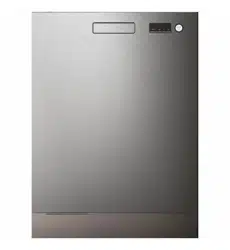Documents: Go to download!
User Manual
- User Manual - (English)
- DBI253IBS - ASKO - Specifications Sheet - (English)
- YOUR DISHWASHER
- Loading the dishwasher
- Using the dishwasher
- Settings
- Care and cleaning
- Troubleshooting
Table of contents
Owner's Guide Dishwasher
YOUR DISHWASHER

Loading the dishwasher
Greener dishwashing
Do not rinse under running water
Simply scrape off large food particles before loading the dishwasher.
Choose a green detergent
Read the environmental declaration on the packaging!
Run programs only with a full load
Wait to run a program until the dishwasher is full. This way you save energy. Use the Rinse & hold program to rinse the dishes if there are any unpleasant odours while you wait for the dishwasher to become fully loaded.
Run programs at a lower temperature
If the dishes are only slightly dirty, you can select a program with a low temperature.
Select Eco
Use when you want to save water and energy. For normally soiled load, such as plates, serving dishes, cups, glasses and so on.
This dishwashing program is designed for an effective wash using as little energy and water as possible. The program washes at a low temperature for a long time.
Open the door a little once the program has finished
Better drying results are achieved if you open the door a little once the program has ended. (If the dishwasher is built-in, the surrounding cabinets must be resistant to any condensation from the dishwasher.)
Connect to cold water
Connect the dishwasher to the cold water supply if the building is heated using oil, electricity or gas.
Connection to hot water supply
Connect the dishwasher to the hot water supply (max. 70 °C) if the building is heated using an energy-efficient means such as district heating, solar power or geothermal power. Choosing a hot water connection cuts dishwashing times and reduces the dishwasher's energy consumption.
NOTE! Do not exceed the permitted water supply temperature. Certain materials used in some cookware cannot withstand high heat.
Fragile dishes
Some cookware is not dishwasher safe. This can be for several reasons. Some materials cannot withstand strong heat, others can be damaged by dishwashing detergent.
Exercise caution with, for example, handmade items, fragile decoration, crystal/glassware, silver, copper, tin, aluminium, wood and plastic. Look for the "Dishwasher safe" marking.
Fragile decoration
Porcelain with decoration on top of the glazing (the items feel rough) should not be washed in a dishwasher.
Crystal/Glass
By using rinse aid you will improve your drying result. You will also achieve a better dishwashing result with glassware and dishes.
Hand-painted glassware, as well as antique and very fragile items, should not be washed in a dishwasher.
Silver
Silver and stainless steel items should not come into contact, as the silver can become discoloured.
Aluminium
Aluminium can lose its shine if washed in a dishwasher. However, good quality aluminium pans can be washed in a dishwasher, even if some of the shine will be lost.
Cutlery with glued handles
Some types of glue are not dishwasher safe. In such cases, the handles may loosen.
Points to consider
- All dirty surfaces should face inwards and downwards!
- Dishes should not be placed in or on each other.
- Angle dishes with hollows, such as cups, so that the rinse water will run off. This is also important for plastic items.
- Make sure small items cannot fall through the dishwasher basket; place them in the top cutlery tray.
NOTE! Check that the spray arms can rotate freely.
The dishwasher's baskets
The dishwasher is equipped with a top cutlery tray, an upper basket and a lower basket with a cutlery basket.
The appearance of the baskets may differ depending on the dishwasher setup.
Top cutlery tray
The top cutlery tray has space for cutlery, ladles, whisks, serving cutlery and similar items.

Raising the top cutlery tray
- Pull out the top cutlery tray.
- Pull the two locking handles on either side forward to raise the top cutlery tray.
Lowering the top cutlery tray
- Pull out the top cutlery tray.
- Slide the two locking handles on either side downwards and backwards to lower the top cutlery tray.
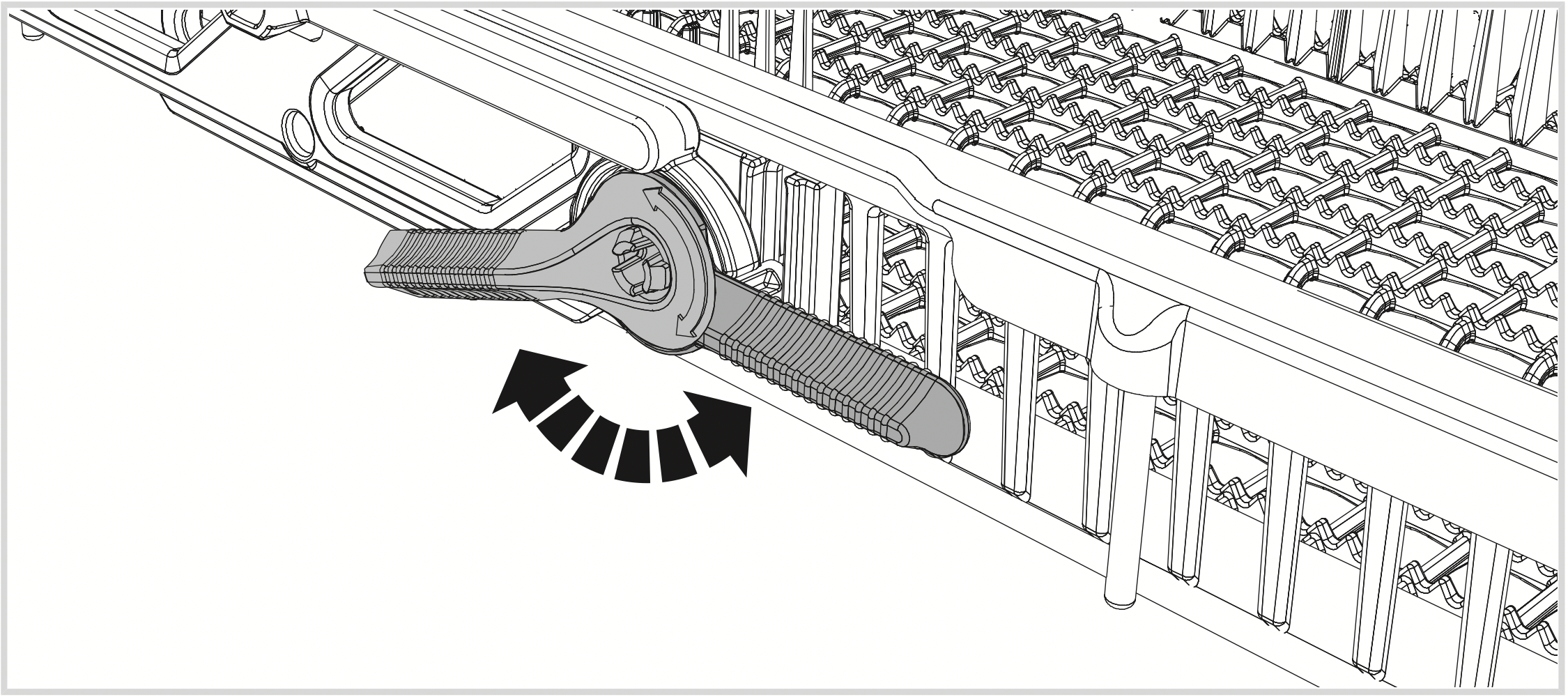
Upper basket
Place glasses, cups, bowls, side plates and saucers in the upper basket. All dirty surfaces should face inwards and downwards! Wine glasses are placed on the wine glass shelf and knives are placed in the knife stand on the right.
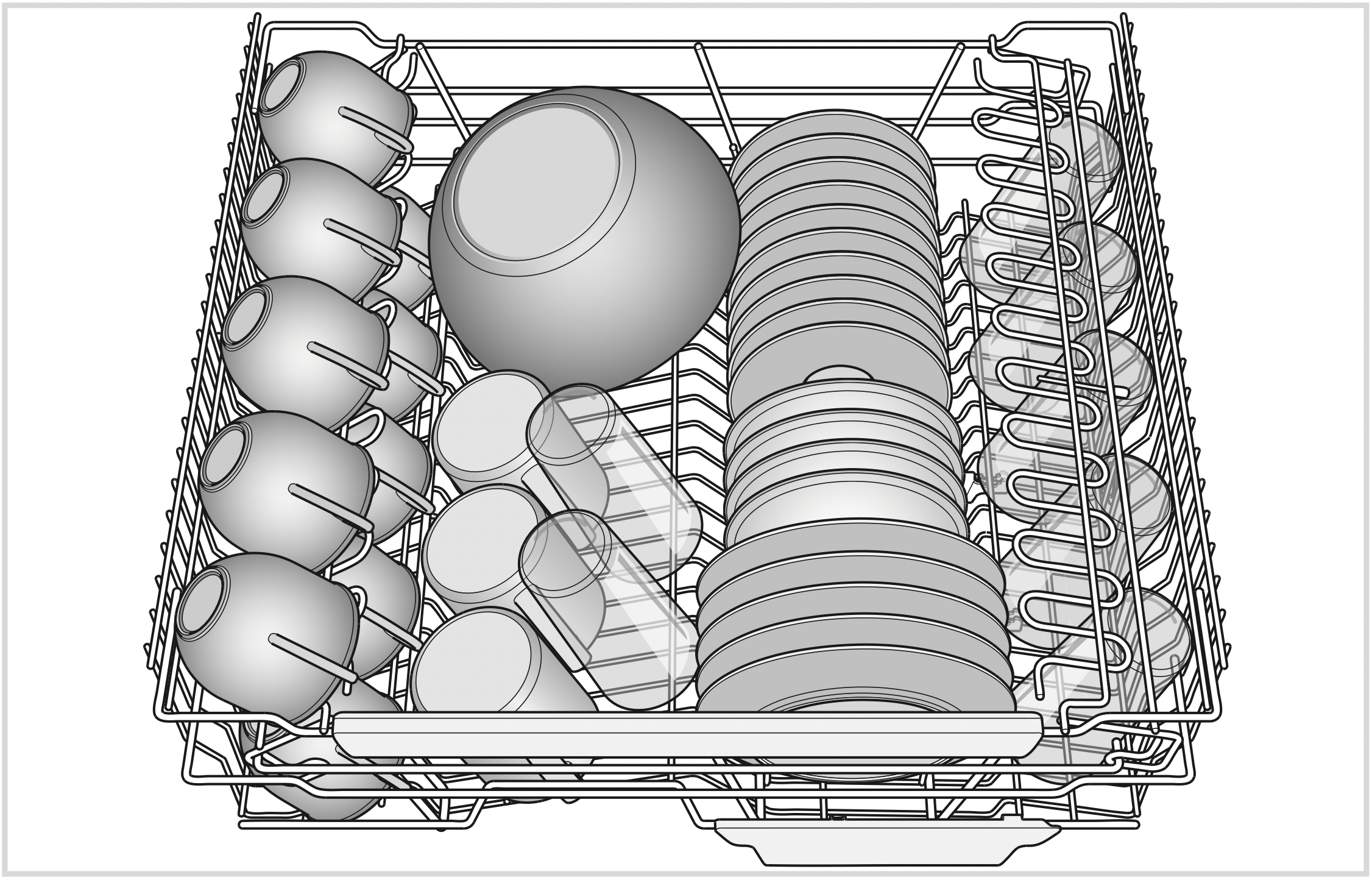

Lower basket
Place plates, side plates, serving dishes, pots and cutlery (in the cutlery basket) in the lower basket.
Place pots and pans in the rear right part of the lower basket to achieve the best dishwashing results from the rear of the two spray nozzles (WideSpray™), which are intended for these types of dishes.

Foldable tines
Lower the foldable tines (plate supports) when washing pots and pans. Release the foldable tines by pressing the catch inwards before adjusting their position.

Washing large plates
Move the foldable tines and their mounts to widen the distance between the tine rows to adapt the lower basket to plates with a diameter greater than 25 cm.
Accessory
Buy a wine glass shelf with space for six tall 1) wine glasses. The wine glass shelf is designed to ensure optimal washing and drying results with tall wine glasses. The wine glass shelf is placed in the rear section of the lower basket. This accessory can be purchased by calling ASKO.
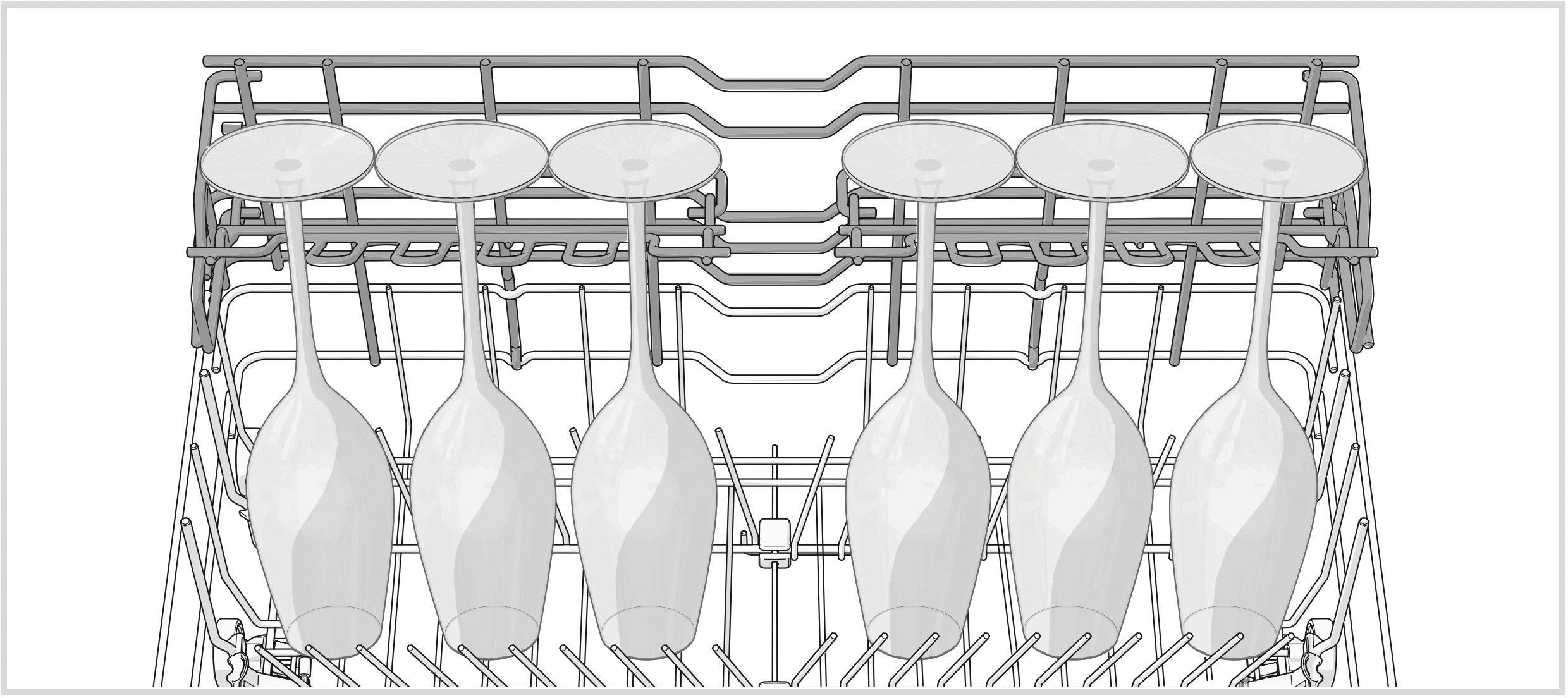
Cutlery basket
Place cutlery with the handles facing down, except for knives, and spread them out as much as possible. Ensure that spoons do not stack inside each other.
The cutlery basket is best placed in the middle at the front of the lower basket to achieve the best dishwashing performance from the unique spray nozzle (Power Zone Cutlery™), which is intended for the cutlery basket.
WARNING! Knives and other pointed items must be placed with the points down in the cutlery basket or horizontally in other baskets.
Fold-down section for small items
The cutlery basket has a fold-down section in the middle for small items, or small shafts, such as electric whisk attachments.
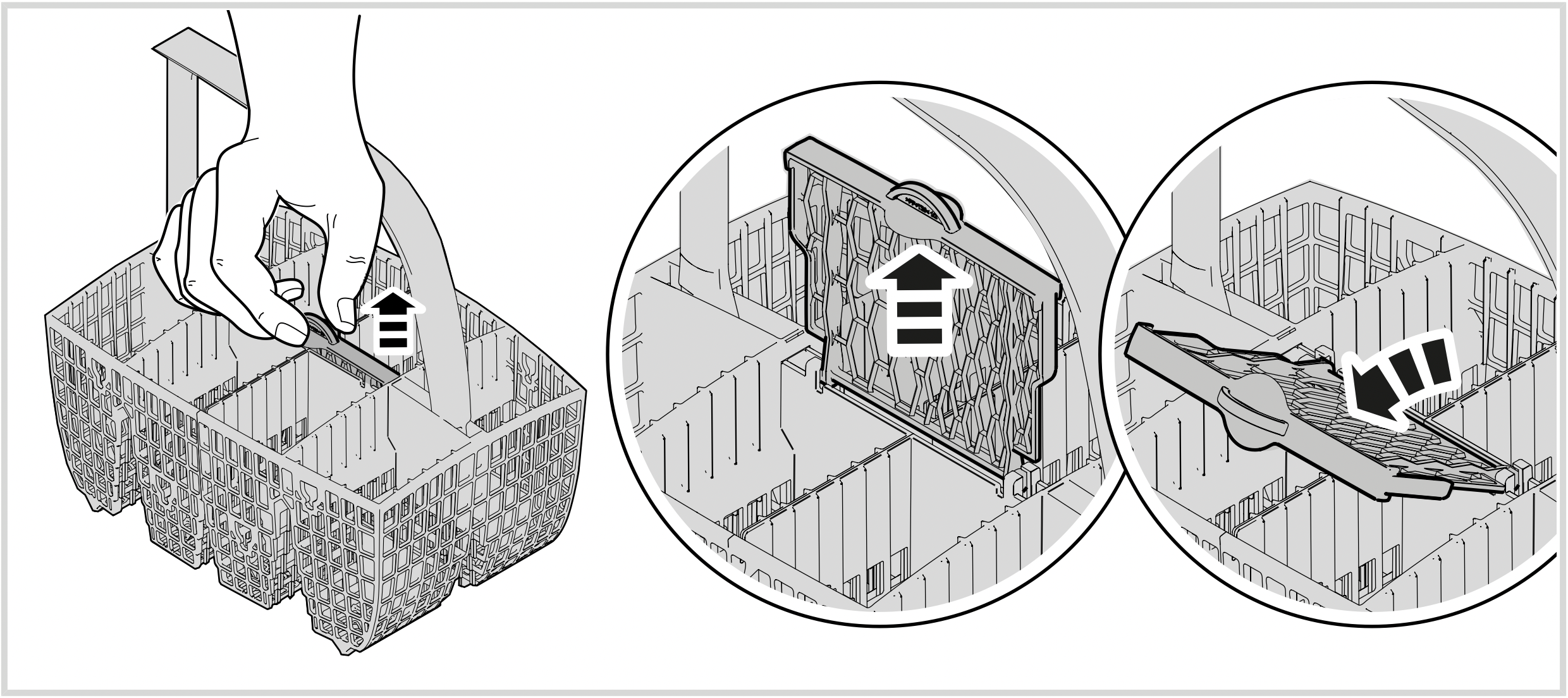
Accessory
Buy an extra cutlery basket. The extra cutlery basket is flexible and can be dismantled and attached to the lower basket or the large cutlery basket to make an extra large cutlery basket. This accessory is available where you purchased your dishwasher.
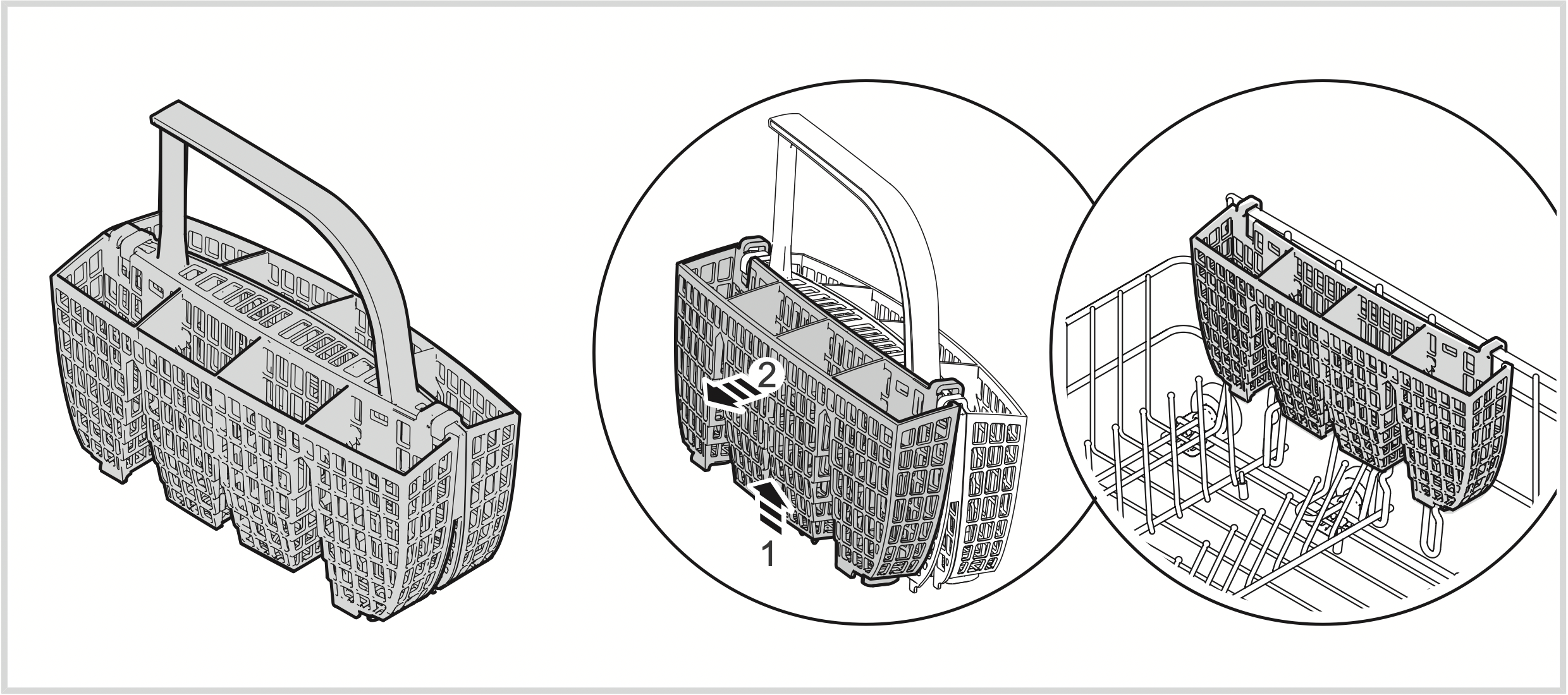
Using the dishwasher
Add detergent
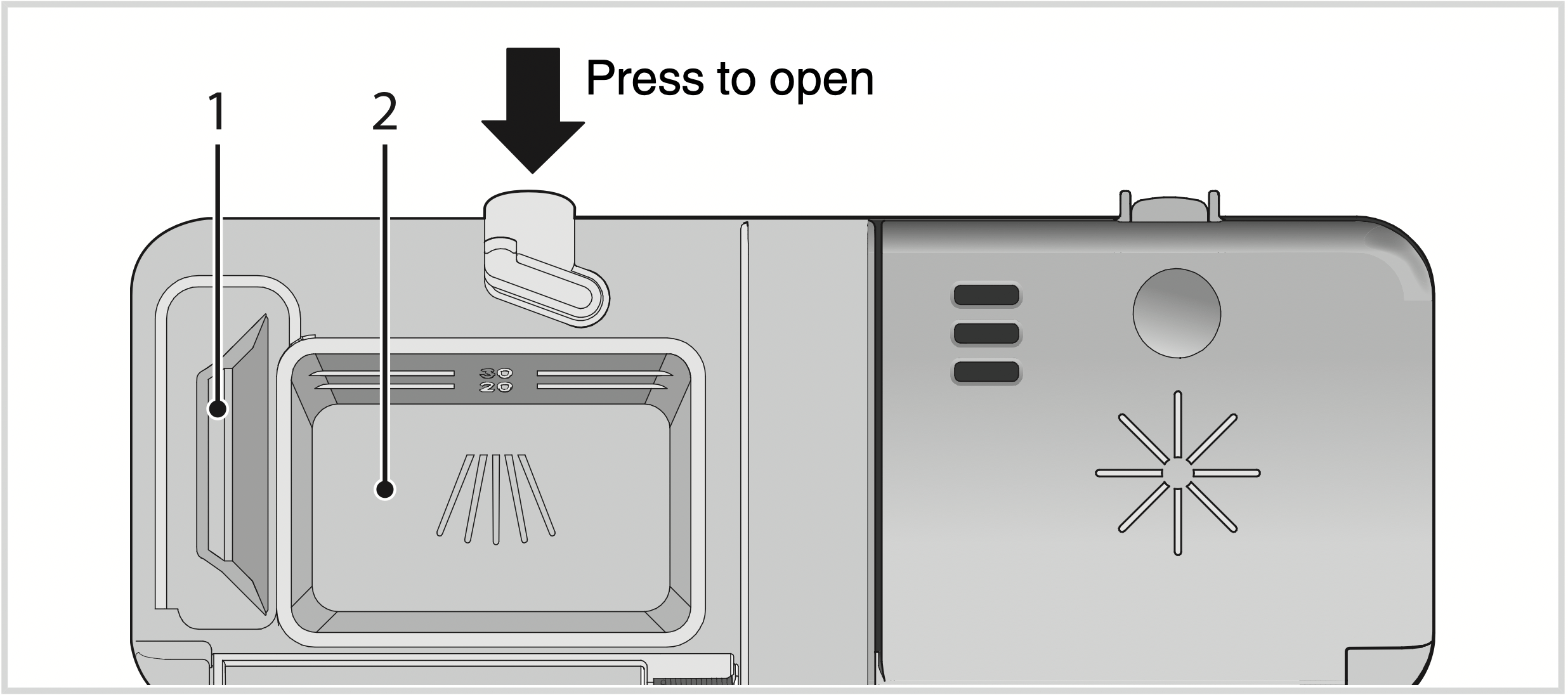
- Prewash detergent compartment
- Main wash detergent compartment
Detergent is added according to water hardness.
Follow the instructions on the detergent packaging.
Too much detergent can result in less effective dishwashing and also entails greater environmental impact.
The detergent compartment must be dry when adding detergent. There is one compartment for the prewash and one for the main wash. If powder or liquid dishwasher detergent is used, add a small amount of the detergent to the prewash compartment. Contact the detergent manufacturer if you have questions about the detergent.
NOTE! Use only dishwasher detergent! Washing up liquid must not be used as the foam that forms prevents the dishwasher from operating effectively.
Dishwasher tablets
Halve the tablet if it is difficult to close the dispenser lid. There is a risk that the detergent will not be released properly if the lid is tight and will not open correctly.
NOTE! Dishwasher tablets are not recommended for short programs (less than 75 minutes). Use powder or liquid dishwasher detergent instead.
All-in-one detergent
There are many types of all-in-one detergents on the market. Read the directions for these products carefully.
NOTE! Optimum washing and drying results are achieved by using normal dishwasher detergent together with separately dispensed rinse aid.
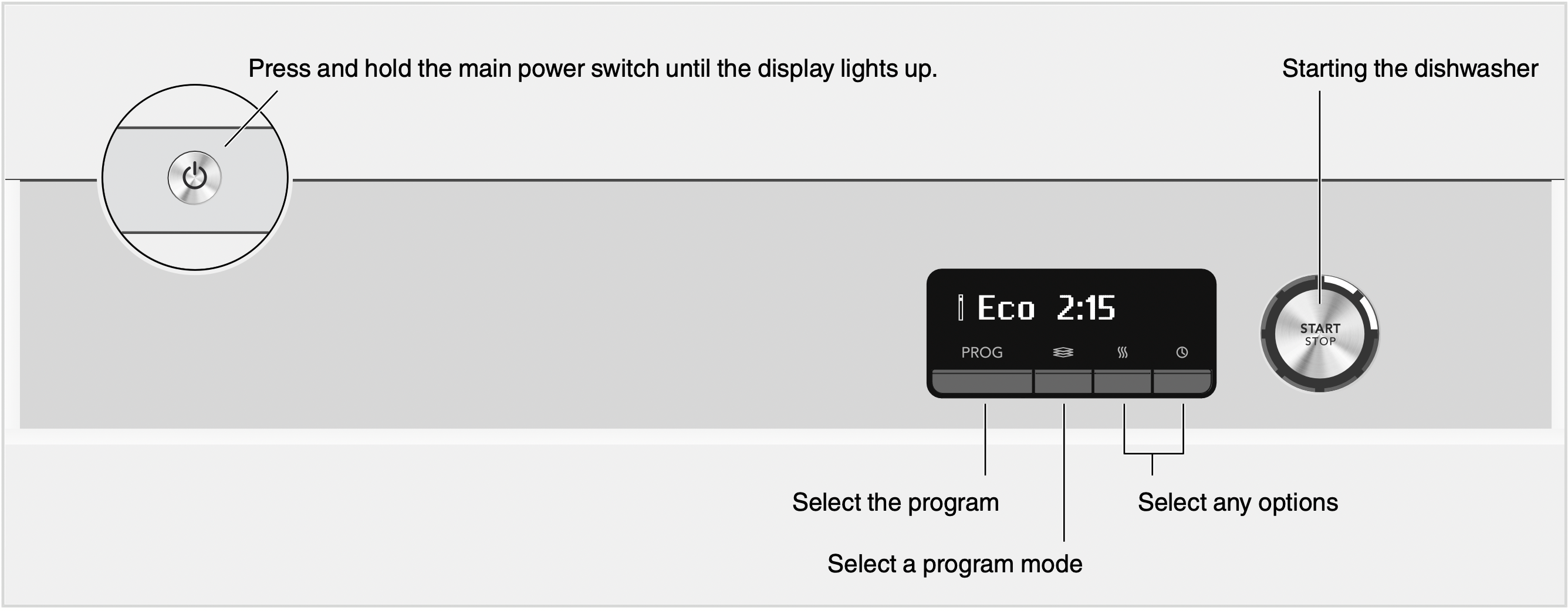
 The main power switch
The main power switch
Open the door and press the main power switch. Close the door. Also turn on the water tap if it is turned off.
Select a program
To select a program, press the navigation button PROG until the desired program is shown on the display.
Select a programme to suit the type of dishes and how dirty they are.
Eco Eco
Use when you want to save water and energy. For normally soiled load, such as plates, serving dishes, cups, glasses and so on.
You can read more about greener dishwashing in the chapter Loading the dishwasher.
 Heavy
Heavy
Use to wash normally soiled load, such as plates, serving dishes, cups, glasses and so on.
 Time program
Time program
The program adapts to the specified running time or finish time. With this program it is important to choose a time suited to how dirty the dishes are.
0:15-0:45 Slightly dirty dishes
1:00-1:30 Normally dirty dishes
2:00-2:30 Very dirty dishes
Press the  option button to set the desired program time.
option button to set the desired program time.
 Rinse & hold
Rinse & hold
Used to rinse dishes while you wait for the dishwasher to become fully loaded.
Hyg Hygiene
This program is designed to meet strict hygiene demands.
 Quick
Quick
A short program for slightly soiled dishes. (This program is not intended for burnt food, such as on oven dishes.)
 Intensive
Intensive
Program for very dirty dishes, such as pans, casserole dishes and oven dishes. If these dishes do not completely fill the dishwasher, you can add plates and the like.
 Select a program mode
Select a program mode
To select a program mode, press the program mode selector until the desired mode is shown on the display. The available program modes vary between programs.
 Speed mode
Speed mode
The program time is shortened, but the dishwasher uses more energy.
 Night mode
Night mode
Lower noise level during the dishwashing program. The program time is extended.
Select an Option
To select an option, press the option button until the desired option is shown on the display. The available options vary between programs.
 Extra Dry
Extra Dry
A higher temperature in the final rinse and a longer drying cycle improve the drying results if you activate this option. Energy consumption is slightly increased.
 Delayed Start
Delayed Start
When you select Delayed Start, the dishwasher will start in 1-24 hours after you have pressed the button Start/Stop and closed the door.
- Press the button once to activate Delayed Start. Press the button several times – or hold it in – to set the desired number of hours.
- Press Start/Stop and close the door. The timer counts down and the dishwasher starts after the selected delay.
If you want to cancel the Delayed Start option, open the door then press and hold Start/Stop for three seconds.
 Starting the dishwasher
Starting the dishwasher
Close the door properly, otherwise the dishwasher will not start. Press Start/Stop until the display shows "Program started".
If the dishwasher is not started within 2 minutes of the last button press, the machine switches off.
Time remaining
Once you have chosen a program, a program mode and options, the time the program took when last used is displayed.
Once you have started the dishwasher, the display shows the remaining program time. The remaining time is updated after the water for the final rinse has been heated.
This may differ somewhat from time to time depending on the temperature of the water supply, the amount of dishes, the ambient temperature and other factors.
During the first run of each program, the remaining time displayed can be slightly misleading, as the dishwasher is estimating the time. When you run the program a second time, the dishwasher will calculate the remaining time based on the previous duration of the program.
Stopping or changing a program
In order not to accidently press a button and cancel the current program, you must press and hold Start/Stop for five seconds if you want to change programs after starting the dishwasher. Add more detergent if the lid of the detergent dispenser has opened. Then choose a new program and press Start/Stop.
If you want to load more dishes
Open the door. The dishwasher stops automatically. Add the dishes and close the door. After a while, the dishwasher continues the program.
If the dishwasher is turned off due to a power failure
If the dishwashing program was not finished, the interrupted program continues when power is restored.
NOTE! During drying, the program is interrupted if the power is cut or the door is open for more than 2 minutes.
Once the program has finished
Once the program has finished, “END” appears on the display.
At the end of the program, you will hear a short beep. Chapter Settings describes how to change this function.
The dishwasher switches off automatically after the program ends. Turn off the water tap after each use.
How to get the best drying results
- Fully load the dishwasher.
- Angle dishes with hollows, such as cups, so that the rinse water will run off. This is also important for plastic items.
- Top up with rinse aid or increase the rinse aid dosage level.
- Activate the Extra Dry option.
- Activate the High temperature setting. See the chapter Settings.
- Activate the Extra Dry setting. See the chapter Settings.
- Open the door a little once the program has finished.
- Allow the dishes to cool before unloading the dishwasher.
Unloading the dishwasher
Hot porcelain is more fragile. Leave the dishes to cool in the dishwasher before unloading them.
Unload the lower basket first to avoid any water drops from the upper basket falling onto the dishes in the lower basket.
Settings
Open the dishwasher's Settings menu
To open the dishwasher's Settings menu, press the navigation button PROG until Settings menu is shown on the display and confirm your selection using the mode selector  .
.
To exit the dishwasher's Settings menu, select Exit and confirm your selection using the mode selector  .
.

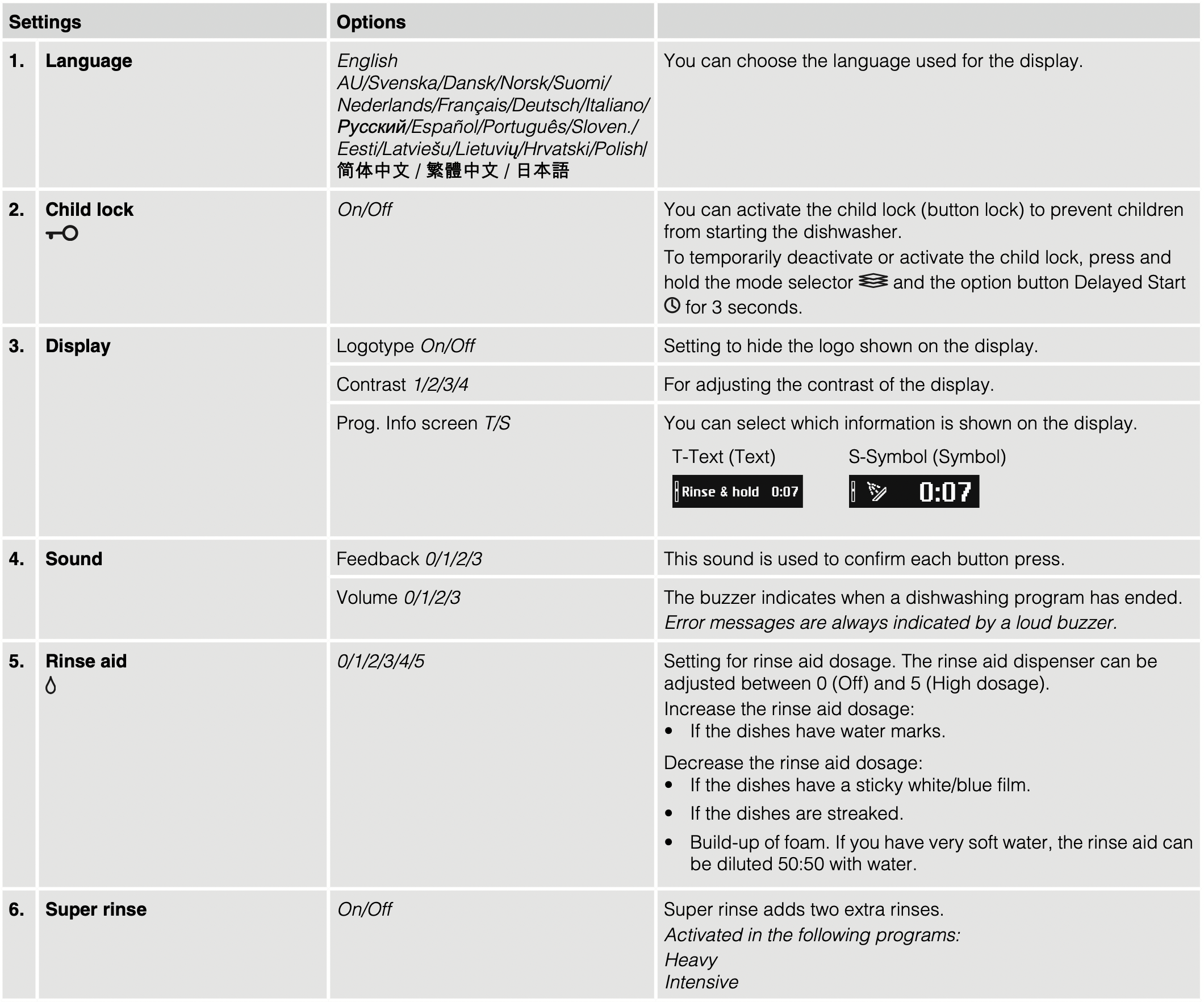

Care and cleaning
 Top up rinse aid
Top up rinse aid
When the rinse aid needs topping up, the above symbol lights on the display.
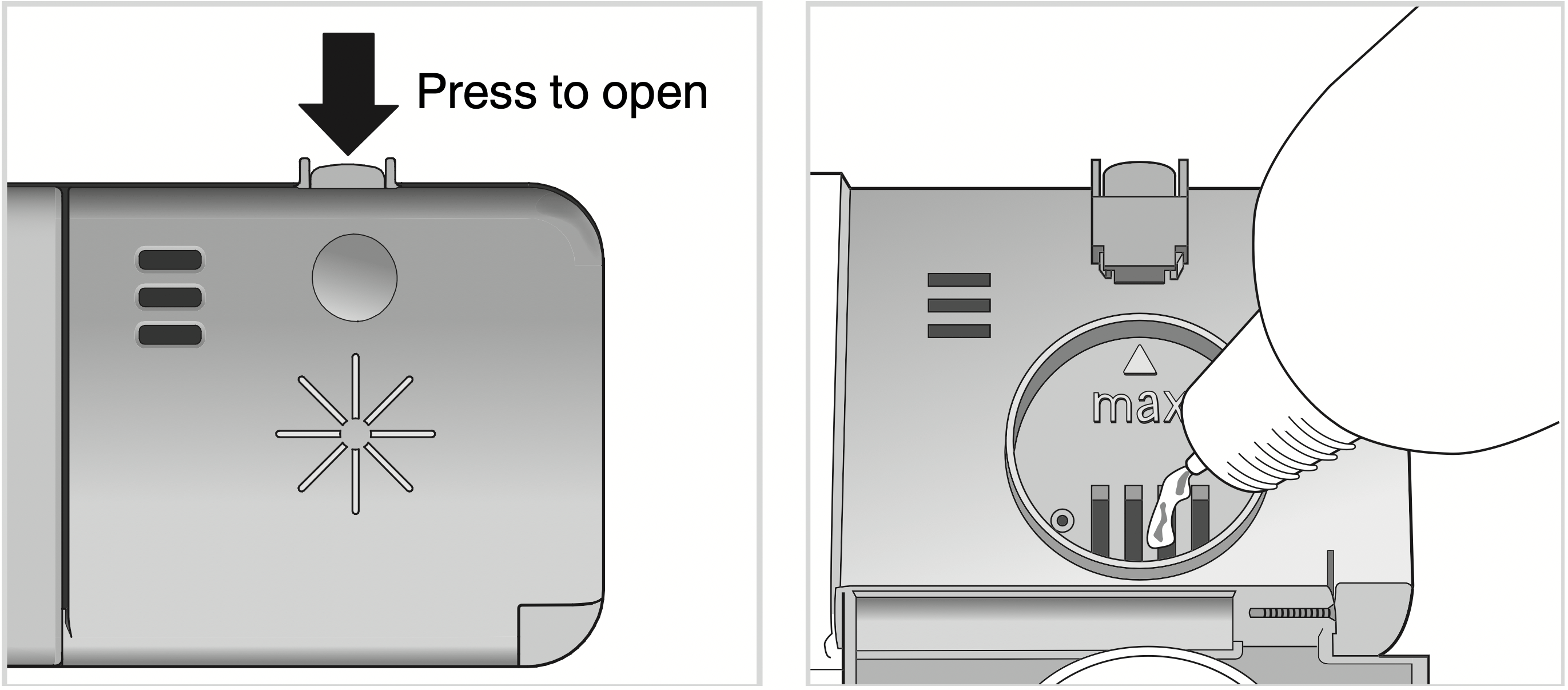
- Open the rinse aid compartment lid.
- Carefully top up with rinse aid to the level marked max.
- Wipe up any splashes of rinse aid around the compartment.
- Close the lid firmly.
After topping up, it may take a while before the symbol goes out.
NOTE! For water with a hardness greater than 10–12 °dH, you ought to use rinse aid with citric acid (known as acid rinse aid).
Coarse filter
The coarse filter traps larger food particles, which cannot get past the drainage pump. Empty the coarse filter when necessary.

- Lift the coarse filter by the handle.
- Empty the coarse filter. Remember to refit it!
Fine filter
Debris that collects on the fine filter is automatically rinsed away during each wash. Clean the fine filter when necessary.
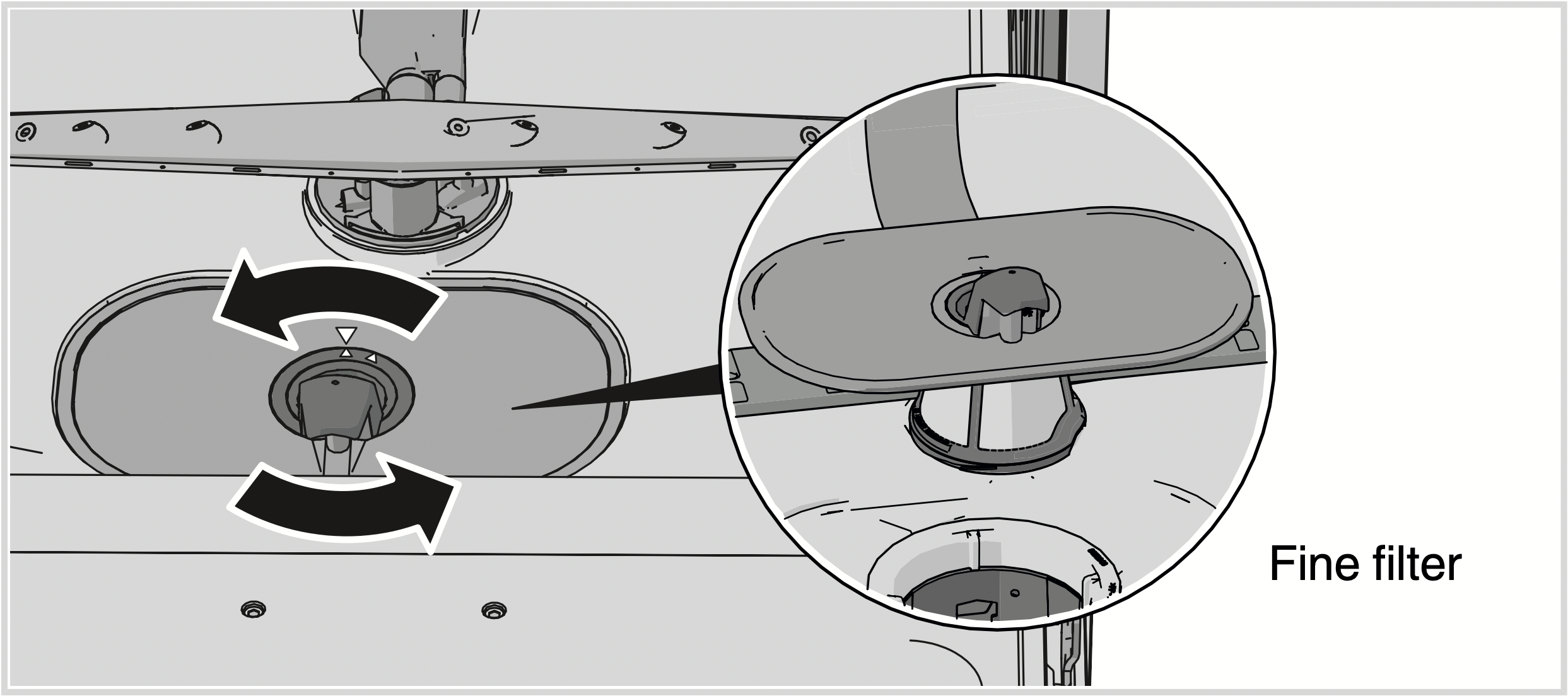
- Turn the handle anticlockwise.
- Lift the filter straight up using the handle. Free the coarse filter to clean the fine filter.
- Refit in reverse order. Check that the edges seal properly when refitting the fine filter.
- Lock the filter in place by turning the handle clockwise to the stop position. The handle should point straight out from the dishwasher.
NOTE! Dishwashing results may be affected if the filters are incorrectly fitted. Note that the dishwasher must not be used without the filters in place.
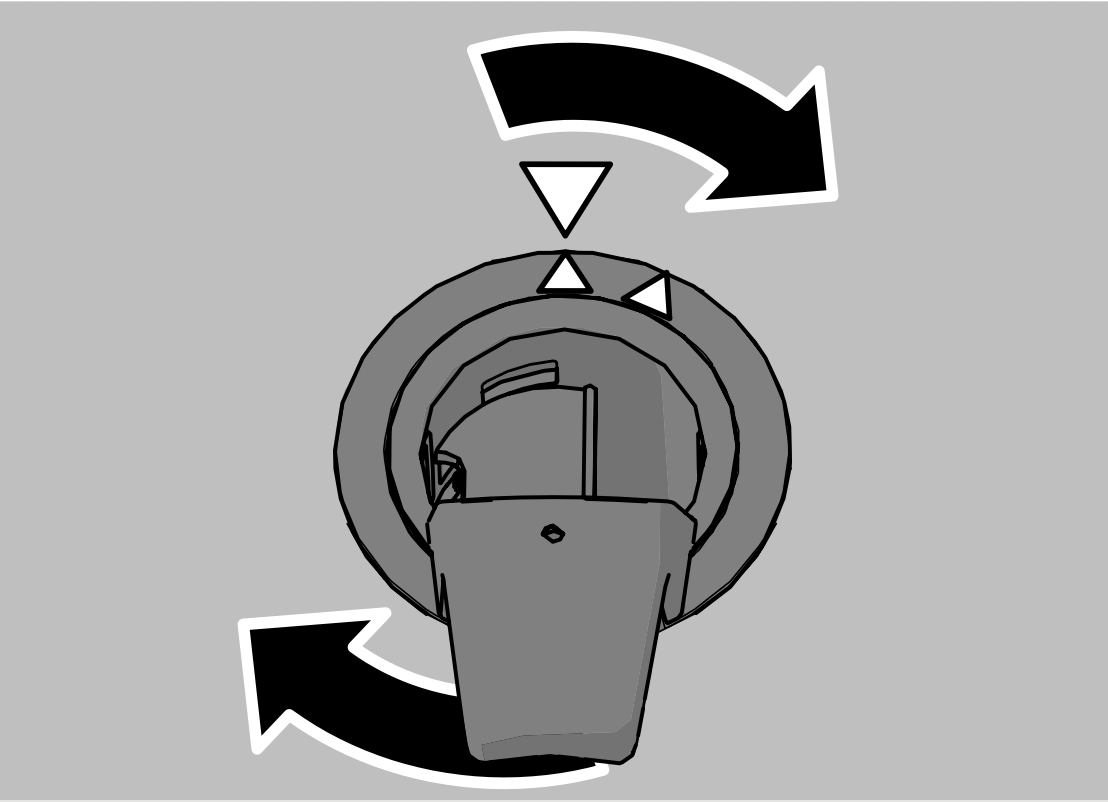
NOTE! Check that the coloured stop on the right in the bottom drain is in place.
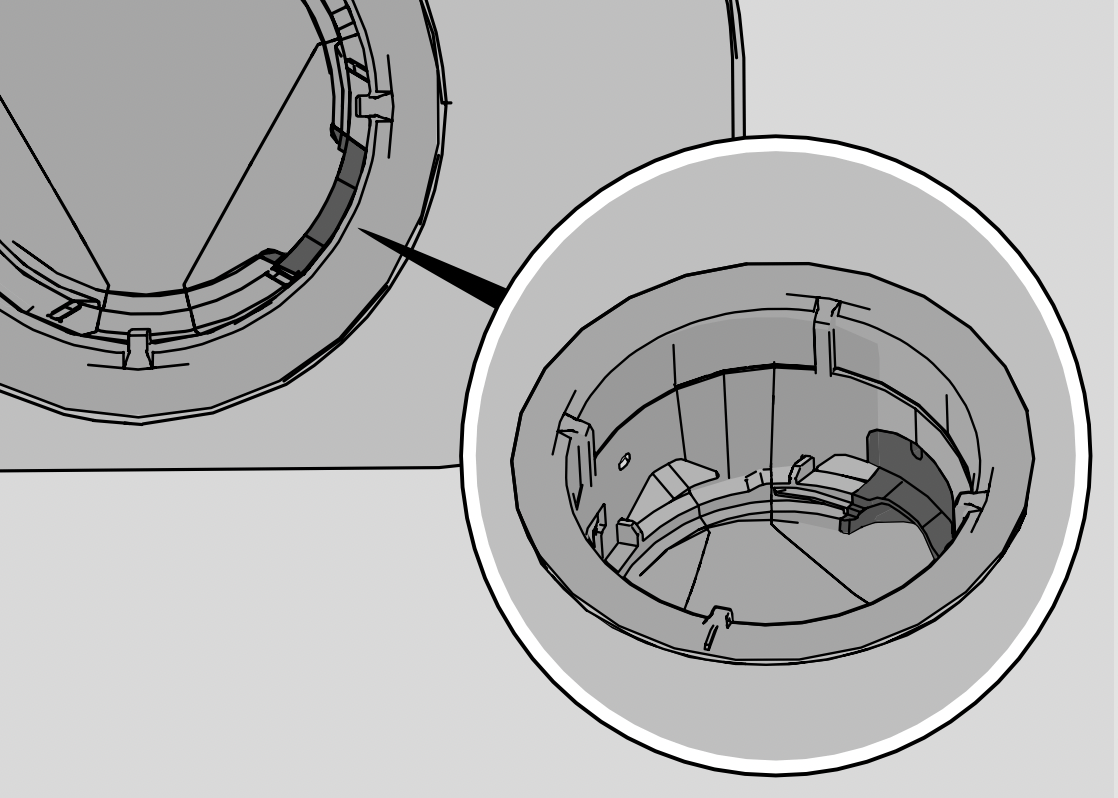
Spray arms
Holes and bearings can sometimes become blocked. Remove any debris using a pin or something similar. The spray arms also have holes on their undersides.
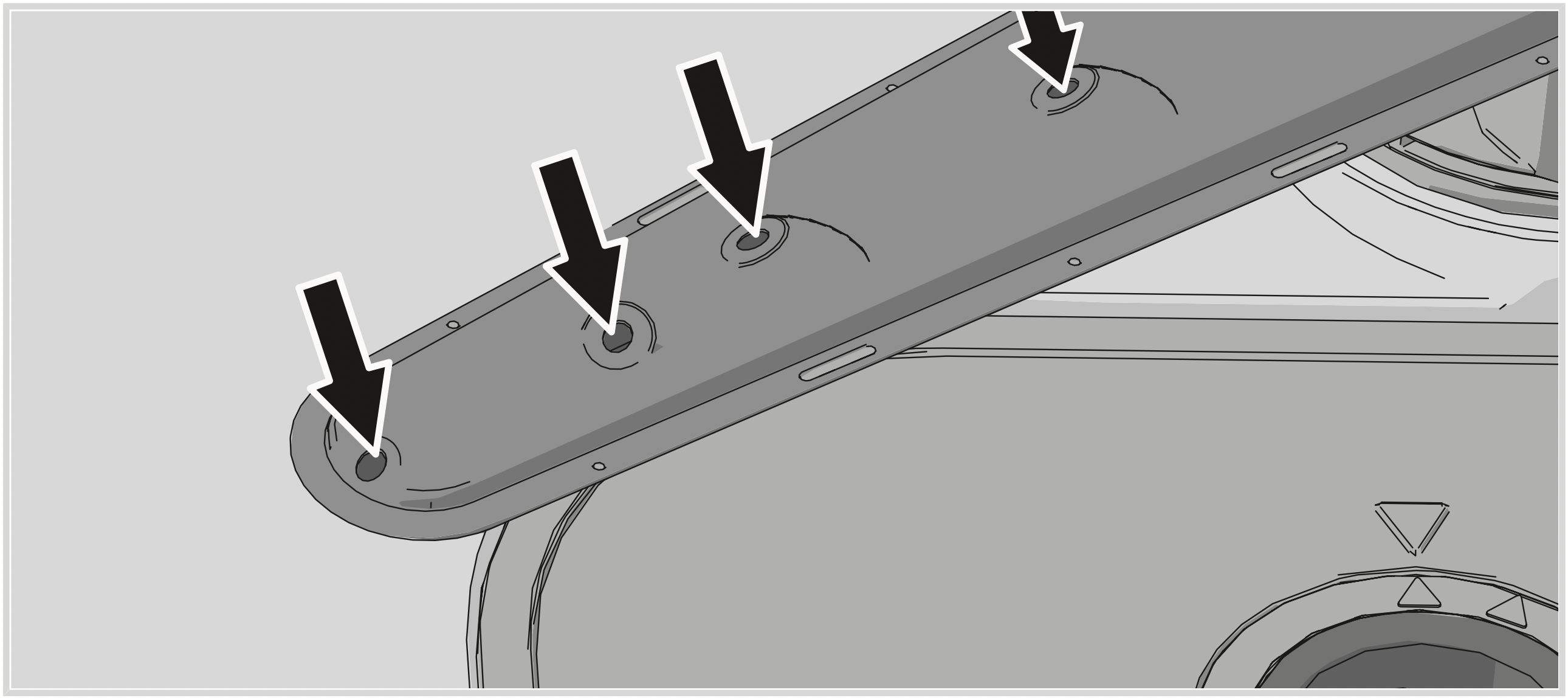
To facilitate cleaning, you can remove the spray arms. Remember to fit them firmly back into place after cleaning.
Top spray arm
- The upper basket must be removed before the top spray arm can be released. See section Upper spray arm.
- Pull out the top cutlery tray. Press the top spray arm up and unscrew the spray arm bearings counter-clockwise to remove the spray arm.
Upper spray arm
- The upper basket must be removed before the upper spray arm can be released. Pull out the upper basket and turn the basket catch on each runner outwards (see illustration). The basket can now be removed.
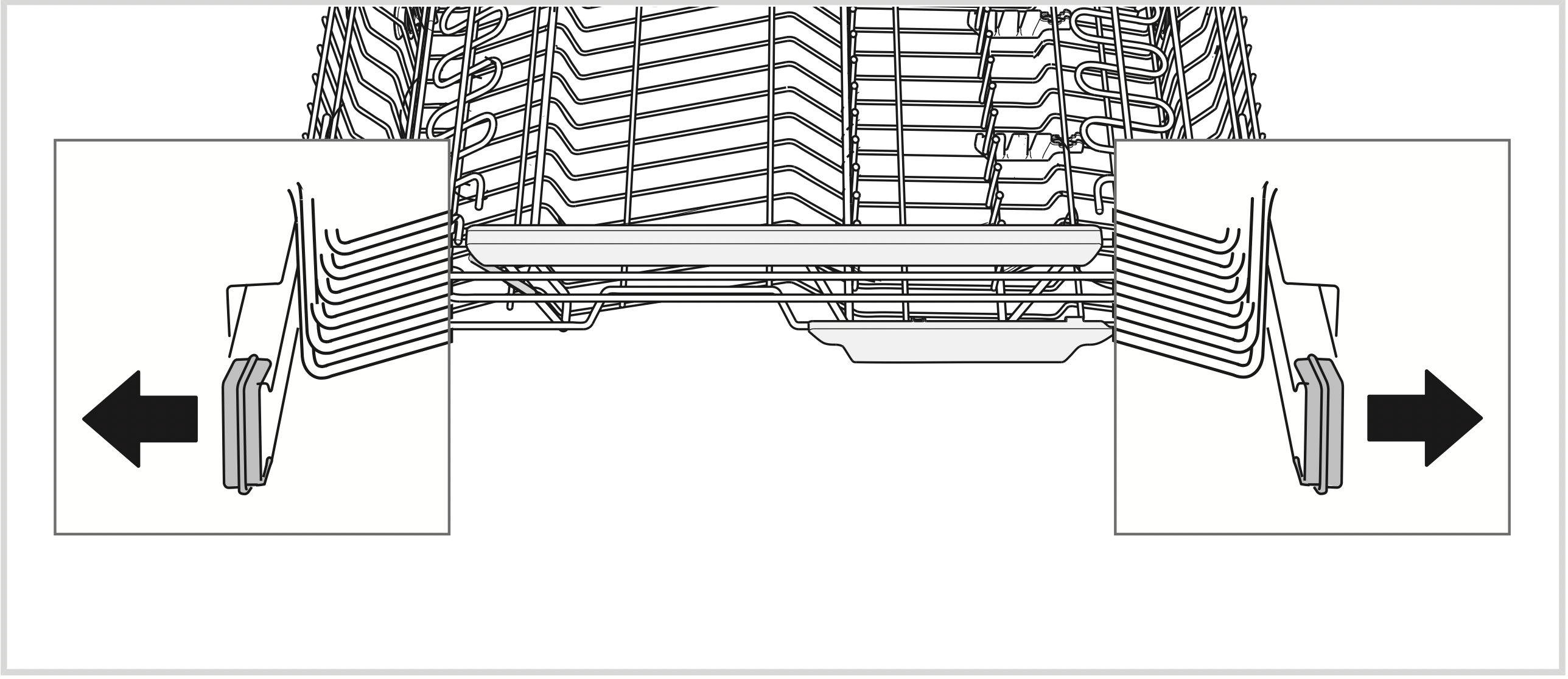
- Pull the upper spray arm straight up to release it.
Lower spray arm
- Pull the lower spray arm straight up to release it.
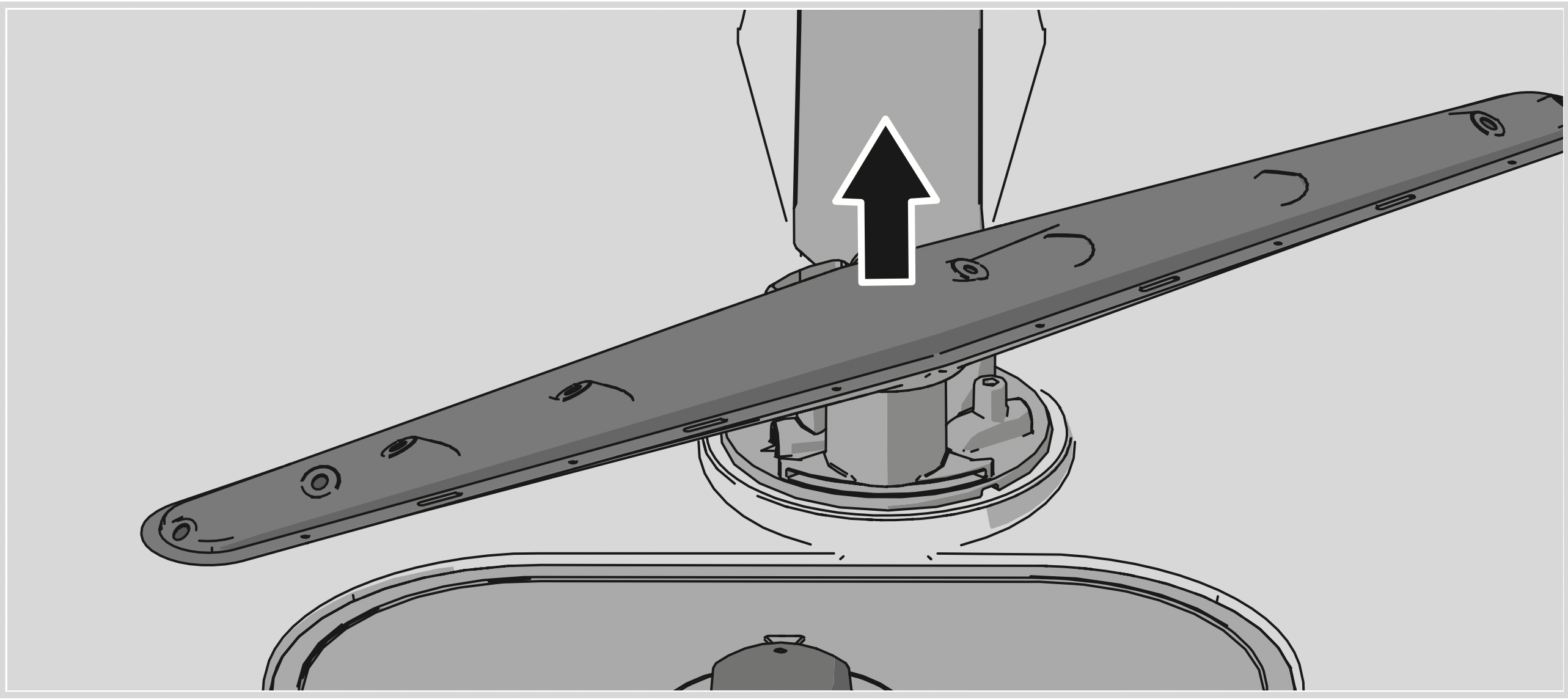
The door and the door seal
Regularly clean the sides of the door and the door seal. Use a slightly damp cloth (with a little cleaner if necessary).
Front panel
Keep the buttons clean and free from grease. Wipe them clean with a dry or slightly damp cloth. Never use cleaners – they can scratch the surface. Use the main power switch to turn off the dishwasher before cleaning the buttons to avoid activating any buttons unintentionally.
The dishwasher tub
The dishwasher tub is made of stainless steel and is kept clean through normal use.
Limescale deposits
If you have hard water, limescale deposits may build up in the dishwasher. If this happens, run the Intensive program with two tablespoons of citric acid in the detergent compartment (with no dishes in the machine). Special dishwasher cleaners are also available on the market.
Unblocking the drainage pump
If the dishwasher still contains water after the programme has finished, something may be blocking the drainage pump. Such items are easily removed.
- Turn off the machine using the main power switch and unplug it from the wall socket.
- Remove the coarse filter and the fine filter.
- Scoop out the water from the dishwasher tub.
- In order to inspect the drainage pump, remove the coloured stop on the right in the bottom drain.
- Turn the pump wheel located behind the drainage pump stop by hand. Carefully remove any items.
- Refit the drainage pump stop along with the fine and coarse filters.
- Plug the machine in again.
If the dishwasher still does not start and a whirring sound is heard, the overflow protection has been activated.
- Shut off the water.
- Remove the plug from the wall socket.
- Call the service department.
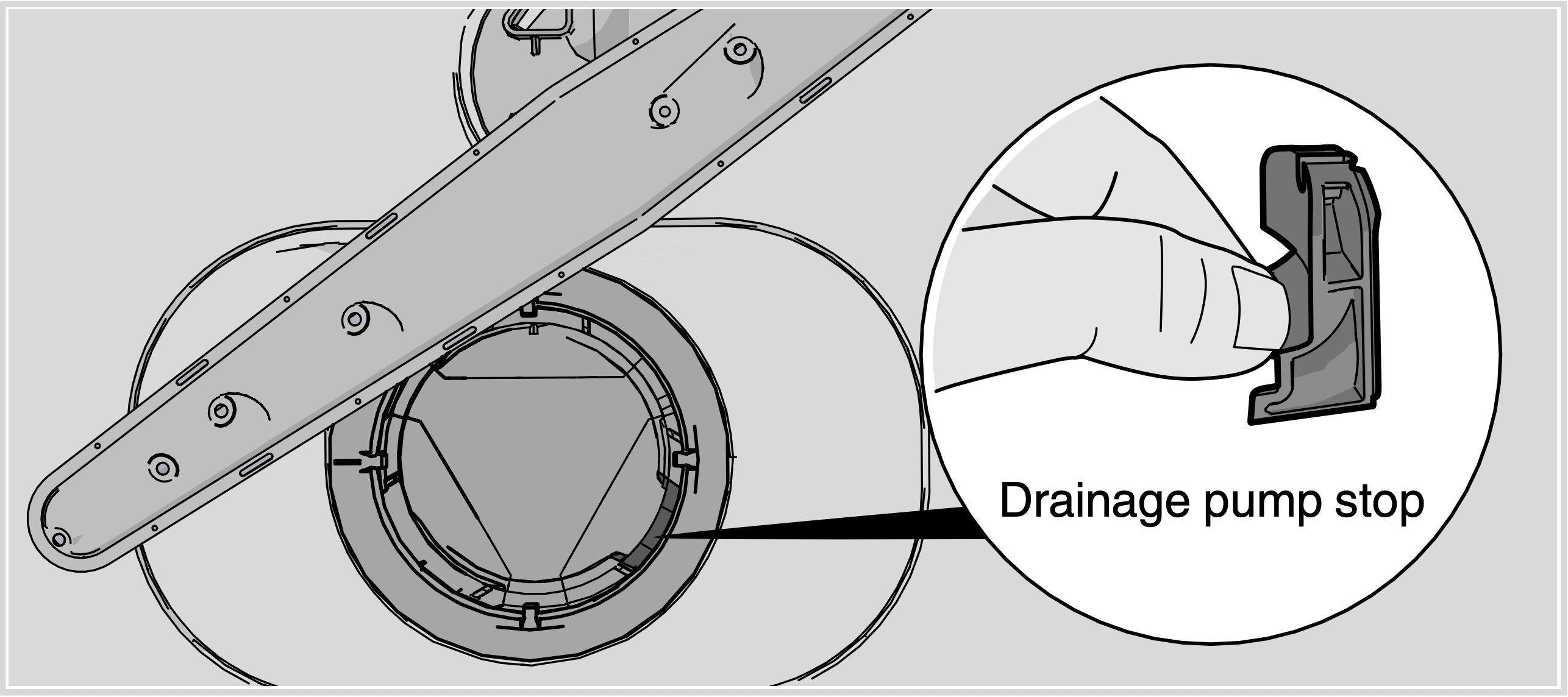
NOTE! Do not forget to refit the drainage pump stop.
Unblocking the inlet hose filter
If the water supply contains small particles, the outer filter on the inlet hose may become blocked, which results in Water inlet fault.
- Turn off the machine using the main power switch and unplug it from the wall socket.
- Turn off the water tap.
- Unscrew the inlet hose.
- Carefully remove the outer filter from the inlet hose and clean it.
- Refit the filter and check that the gasket is correctly positioned.
- Screw the inlet hose firmly into place.
- Plug the machine into the wall socket and turn on the water tap. Allow the pressure to settle for a while and check that the connection is watertight.
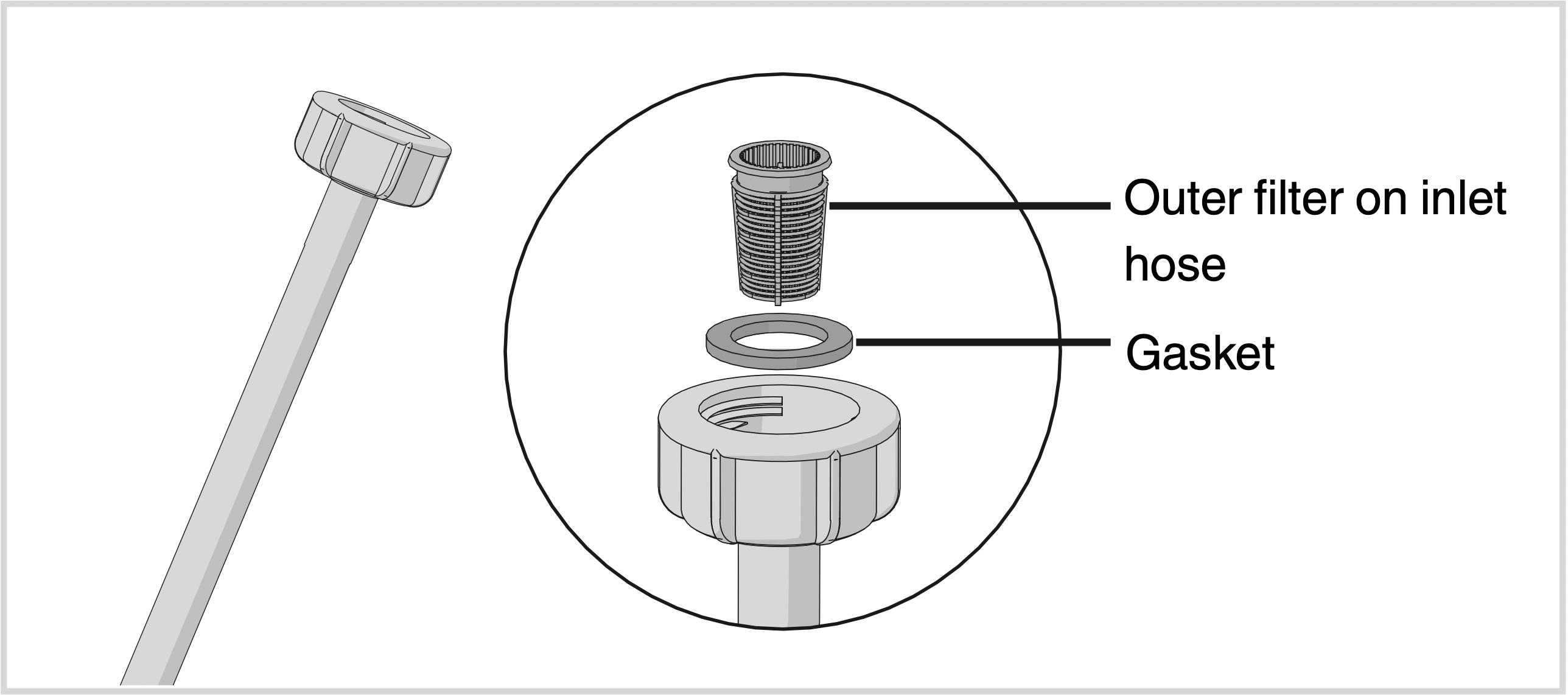
Troubleshooting
| Type of fault on the display | Action | |
|---|---|---|
| F10 | Overfilling water 1 | Clear the drainage pump. See the chapter Care and cleaning. If the problem persists, call the service department. |
| F11 | Water outlet fault |
See “Water remains in the dishwasher” in the table “Problem” below. If the problem persists, call the service department. |
| F12 | Water inlet fault |
Check whether dishwasher inlet hose is connected to a pressure limiting valve (some pressure limiting valves may restrict the supply of water to the dishwasher). Check that the water tap is on. Check that the outer filter on the inlet hose is not blocked. See Unblocking the inlet hose filter in the chapter Care and cleaning. If the problem persists, call for service. |
| F40 | Inlet valve leakage | Turn off the water tap and call the service department. |
| F52 | Water level fault |
Clean the coarse and fine filters. Check that the outer filter on the inlet hose is not blocked. If the problem persists, call the service department. |
| F54 | Overfilling water 2 | Turn off the water tap and call the service department. |
| F56 | Circ. pump fault |
Call the service department. |
Press any button to clear the error message.
| Problem | Possible causes | Action |
|---|---|---|
| Pressing the main power switch has no effect. | The door is closed. |
Open the door. The main power switch only works when the door is open. |
| The buttons do not react when pressed. | You have pressed the buttons too soon after opening the door. |
Wait a moment then try again. |
| Child lock (button lock) activated. |
See the chapter Settings. |
|
| The buttons are dirty. |
Clean with a dry or slightly damp cloth. |
|
| Cannot close door. |
The baskets are not correctly positioned. |
Check that the baskets are correctly positioned horizontally. |
|
Check that the dishes are not blocking the baskets from sliding properly into place. |
||
| The dishwasher does not start. |
The Start/Stop start button has not been pressed for long enough. |
Press and hold Start/Stop until the display shows "Program started". |
|
The door is not properly closed. |
Check. | |
|
You have opened the dishwasher to add more dishes while a program is in progress. |
Close the door and wait. After a while, the dishwasher continues the program. |
|
|
A fuse/circuit breaker has been tripped. |
Check. | |
|
The plug is not plugged into the wall socket. |
Check. | |
|
The water tap is turned off. |
Check. | |
|
Overflow/leaks |
Check. | |
|
A whirring sound (the drainage pump) is heard from the dishwasher and does not stop when the main power switch is turned off. |
Turn off the water tap. Pull out the plug and call the service department. | |
|
Check that the Delayed Start option has not been selected. |
Press and hold Start/Stop for three seconds if you want to cancel the Delayed Start option. |
|
| The dishes are not clean. |
The spray arms do not rotate. |
Check that the dishes are not blocking the spray arms. |
|
Spray arm holes or bearings blocked. |
Clean the spray arms. See Chapter Care and cleaning. | |
|
Unsuitable dishwashing program. |
Choose a longer programme. | |
|
Incorrect detergent dosage. |
Dose according to water hardness. Far too much or far too little detergent results in poorer dishwashing results. |
|
|
Old detergent. Detergent is a perishable product. |
Avoid large packages. | |
|
Dishes loaded incorrectly. |
Do not cover porcelain with large bowls or the like. Avoid placing very tall glasses in the corners of the baskets. |
|
|
Glasses and cups have toppled over during the program. |
Place dishes to sit steady. | |
|
The filters are not fitted correctly. |
Check that the filter handle is locked in the stop position. The handle should point towards the back of the dishwasher. |
|
|
Drainage pump stop missing. |
Check that the coloured stop on the right in the bottom drain is in place. See the chapter Care and cleaning. |
|
| Spots on stainless steel or silver. |
Some foodstuffs, such as mustard, mayonnaise, lemon, vinegar, salt and dressings, can mark stainless steel if left for too long. |
Rinse off these types of foodstuffs if not starting the dishwasher immediately. Use the Rinse & hold program. |
|
All stainless steel can cause spots on silver if they come into contact during dishwashing. Aluminium can also cause spots on dishes. |
In order to avoid marks and tarnishing, separate dishes made from different metals, such as silver, stainless steel and aluminium. | |
| Spots or films on the dishes. |
Incorrect rinse aid dosage setting. |
See the chapter Settings. |
|
Too high temperature and/or too much detergent can cause etching on crystal. Unfortunately, this cannot be repaired, only prevented. |
Wash crystal at a low temperature and with a conservative amount of detergent. Contact the detergent manufacturer. | |
|
The dishes have a sticky white/blue film. |
Rinse aid dosage setting too high. | Reduce the dosage. See the chapter Settings. If you have very soft water, you may want to dilute the rinse aid 50:50 with water. |
|
Spots left after washing. |
Lipstick and tea can be difficult to wash off. | Use a detergent with a bleaching agent. |
| Detergent residue in the detergent compartment after dishwashing. | The detergent compartment was damp when adding detergent. |
The detergent compartment must be dry when adding detergent. |
|
The detergent compartment is blocked. |
Check that the dishes are not preventing the detergent compartment from opening. |
|
| Rattling sound when dishwashing. |
The dishes are not correctly placed or the spray arms are not rotating. |
Check that the dishes are placed securely. Spin the spray arms to make sure they can rotate. |
|
1 minute appears in the display. |
The program is taking longer than estimated. |
No action. The programme time is stored and next time the programme is run the corrected time will be displayed. |
| Water remains in the dishwasher. |
The filters are blocked. |
Clean the coarse and fine filters. |
|
The filters are not fitted correctly. |
Check that the filter handle is locked in the stop position. The handle should point towards the back of the dishwasher. |
|
|
Debris in the drainage pump. |
Clean the drainage pump. See the chapter Care and cleaning. |
|
|
Drainage pump stop missing. |
Check that the coloured stop on the right in the bottom drain is in place. See the chapter Care and cleaning. |
|
|
Kink in drainage hose. |
Check that the hose is free from kinks and sharp bends. | |
|
Blocked drainage hose. |
Disconnect the drainage hose where it connects to the sink unit's water trap. Check that no debris has fastened and that the connection has an inner diameter of at least 14 mm. |
|
| Bad odour in dishwasher. |
Dirt around the seals and in corners. |
Clean with washing-up brush and low foaming cleaner. |
|
Low temperature programs have been selected for a prolonged period. |
Run a program with a higher temperature once or twice a month. | |
|
The dishes are not dry enough. |
Depending on the load, the programme's drying cycle may be insufficient. | Activate the Extra Dry option. |
|
The dishwasher is not fully loaded. |
Fully load the dishwasher. | |
|
Rinse aid needs topping up or dosage is set too low. |
Top up with rinse aid or increase the rinse aid dosage level. See the chapter Settings. |
|
|
Open the door a little once the program has finished. |
See other models: 1646 DBI653IBW DBI654IB.S.AU DBI653IBS DBI243IBS
